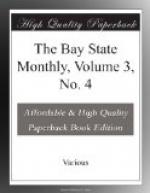Mr. Hobart was characterized “as a bold man, who would speak his mind.”
The story of the contest with the authorities is long and tedious, and it would not serve the purpose of this article to relate it fully, but we can see in the brief statement above that, whether the minister and his people were right or wrong, they had in them that energy, pluck, and persistency which men who would establish strong foundations of society and municipal prosperity must have.
Many interesting events in the early history of the town must be passed over. The complete history is being prepared under the authority of the town, and he who has curiosity concerning it will, ere long, have an opportunity to gratify it. Suffice it to say that the town suffered, in common with all the early settlements, from the Indians, though not extraordinarily; the usual precautions were taken to prevent assaults, and considerable attention was paid to the maintenance of the military. The whole civil history of the town has been one of steady prosperity, of rather slow growth in population.
The first church in Hingham was formed in 1635, on the settlement of the town, with Rev. Peter Hobart as its first minister.
The first house for public worship was erected by the first settlers of the town, probably within a short time after its settlement in 1635. It was surrounded by a palisado, and surmounted by a belfry with a bell, and was undoubtedly a plain structure, so far as the scanty records give any light upon it. It stood upon a hill, in front of the present site of the Derby Academy, in the centre of what is now Main street. But the chief curiosity of Hingham to-day is the second meeting-house, known as the “Old Meeting-house.” It is believed that no house for public worship exists within the limits of the United States, which continues to be used for the purpose for which it was erected, and remaining on the same site where it was built, which is so old as this. It is said that timbers from the first were used in the construction of the present house. The brass tablet on its wall states:—
“This Church was gathered in 1635. The frame of this Meeting-house was raised on the twenty-sixth, twenty-seventh, and twenty-eighth days of July, 1681, and the house was completed and opened for public worship on the eighth of January, 1681-2. It cost the town L430 and the old house.”
In 1881 there were elaborate commemorative services on the occasion of the 200th anniversary of the building of the meeting-house.




